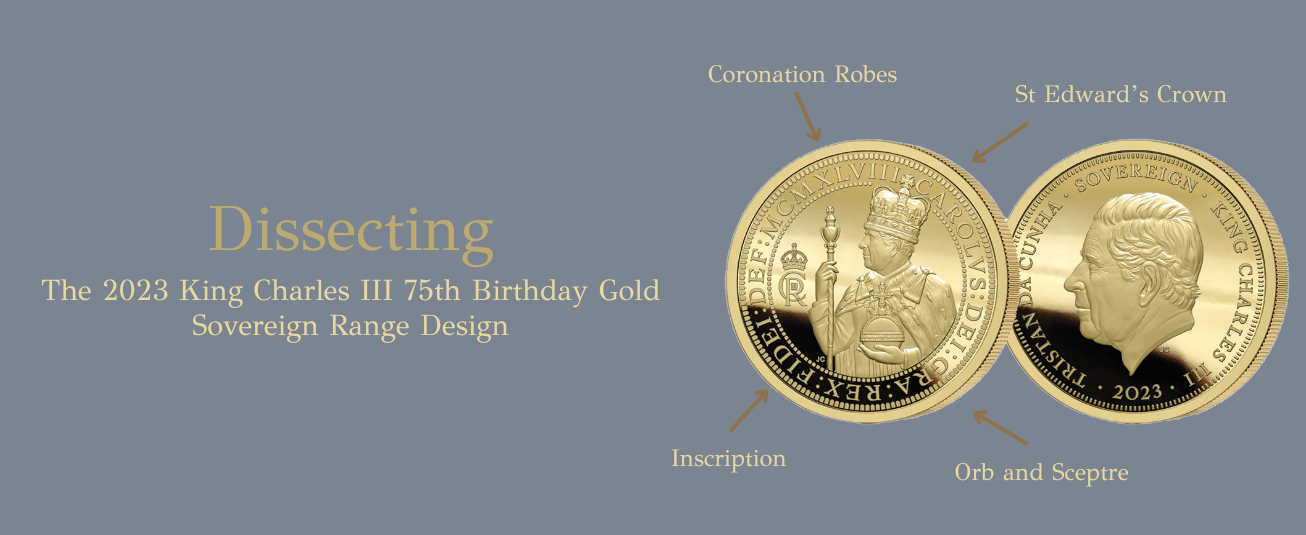
Our latest gold sovereign range; The 2023 King Charles III 75th Birthday Gold Sovereign Range, features a design in the style of the gold ‘Carolus’ coins of the King’s 17th-century predecessor and namesake, King Charles I, making an intriguing historic connection between British monarchs some four centuries apart.
Each coin in this series features the same design: namely, a portrait of King Charles III, wearing the St Edward’s crown and resplendent in his coronation robes, holding the orb in one hand and the sceptre in another. In this blog, we will be dissecting the key features of the coin design from this remarkable range…
Portrait of King Charles III
King Charles III is shown in half-length profile, and this depiction echoes that of his predecessor and namesake, King Charles I, who was similarly portrayed on gold coins of his reign which became known as the ‘Carolus’ (the Latin derivation of Charles).
St Edward’s Crown
Traditionally, the only time the St Edward’s Crown is worn is during the moment of crowning. Made for King Charles II in 1661, this crown was a replacement for the original crown which had been melted down in 1649. It is believed that the original crown dated back to the eleventh-century for King Edward the Confessor. Conventionally, the crown was not allowed to leave Westminster Abbey, therefore, a second crown was created for the procession out of the coronation ceremony.
Although it is not an exact replica, the St Edward’s Crown was commissioned by the Crown Jeweller at the time, Robert Vyner, and features four crosses-pattée and four fleurs-de-lis, and two arches. Weighing almost five pounds, the St Edward’s Crown is one of the heaviest royal crowns, and is topped with an orb and a cross to symbolise the Christian faith. The solid gold frame also features precious stones such as rubies, sapphires, topazes, amethysts, garnet and tourmalines.
Coronation Robes
During the coronation ceremony, the monarch enters wearing the Robe of State, but this is removed and replaced with a plain robe. Once they have been invested, they will then wear the Stole Royal and with the Robe Royal over the top. Whilst wearing these two items of regalia, the monarch is invested with the Orb, Sceptres and Ring. After the ceremony, the Stole Royal and Robe Royal are removed, and replaced with the Imperial Robe for the procession from Westminster Abbey.
For the King’s coronation this year, a new stole royal was made, which took inspiration from Queen Elizabeth II’s stole in 1953; the year of her coronation. It features a dove which represents the Holy Spirit, the emblems of the four countries of the United Kingdom, a Tudor-style crown, and a pattern similar to the Cosmati Pavement situated in Westminster Abbey.
Orb and Sceptre
The Sovereign’s Orb is a golden globe, surmounted by a cross, and is used during the coronation ceremonies of British monarchs. It is used as a way of reminding the monarch that the power they have obtained is derived from God. Representing the Crown’s power and sovereignty, The Sovereign’s Sceptre, featuring a cross, is also part of the Coronation Regalia and both items have been used during every coronation ceremony since 1661.
In a reflection of the changes that have taken place to the monarchy over the centuries, while the original ‘Carolus’ depicted King Charles I holding a sword and olive branch, in this new 2023 striking, King Charles III is shown holding an orb and sceptre. Thus our new monarch appears less warlike, and more respectful of his subjects and of divine authority.
Inscription meanings:
CAROLVS – Also known as ‘Carolus’, this is Latin for the name ‘Charles’.
DEI – This is the Latin name for ‘God’.
GRA – This means ‘Grace’. Therefore, when you combine DEI and GRA together, it says ‘By the Grace of God’.
REX – This is Latin for King, or ruler. The equivalent for a Queen is ‘REG’.
FIDEI – When combined together with DEF, this is the title ‘Defender of the Faith’.
DEF – As above, when combined together with FIDEI, it is the title ‘Defender of the Faith’.
MCMXLVIII – This is the Roman numerals for 1948; the year of King Charles’ birth.
